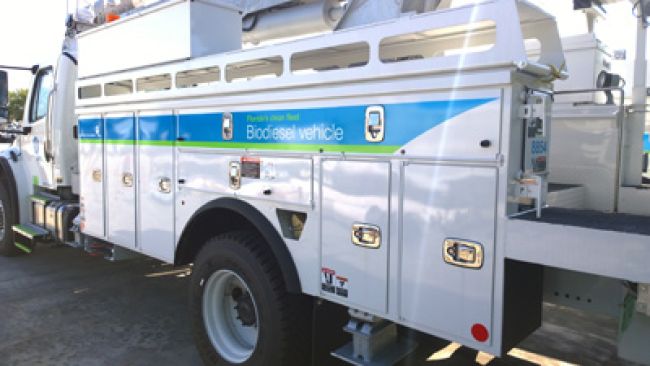
Should Your Utility Fleet Consider Using Biodiesel?
Sustainability is a goal for many utility fleets, but there may not be enough money in the budget – or full stakeholder support – to do all it takes to meet that goal, including overhauling infrastructure, adding new vehicles to the fleet and training staff.
That’s where biodiesel can come into play.
“Biodiesel can be burned in any vehicle, and you don’t have to make infrastructure changes,” said Patti Earley, fleet fueling operations specialist for Florida Power & Light Co. “The fuel tanks don’t need modifications. The fuel equipment isn’t different. It’s very easy. And with biodiesel, you can burn B20 one day and use ultralow sulfur diesel the next without any problems.”
Biodiesel – a fuel made from feedstocks including recycled cooking oil, soybean oil and animal fats – typically is named based on the percentage of biodiesel found in a particular blend. B20, for instance, is 20 percent biodiesel and 80 percent petroleum diesel; it also is the most common blend. Florida Power & Light has used biodiesel since 1999, up to B35. The utility runs all of its diesel equipment on biodiesel and has logged more than 150 million miles.
Proving just how seamless the conversion is, Earley noted that crews from other utilities who have helped out in storm recovery efforts have used biodiesel from Florida Power & Light and “weren’t aware” they were doing so.
Standards, Specifications, Support
Biodiesel production continues to increase year over year, from approximately 25 million gallons in the early part of the century to nearly 3 billion gallons in 2016, according to the National Biodiesel Board (http://biodiesel.org/), which – among other things – has worked on developing standards to help ensure biodiesel users reap measurable benefits. “It doesn’t do any good to put a new fuel out in the marketplace that there will be issues with,” said Scott Fenwick, the board’s technical director.
That has meant working closely with vehicle and engine manufacturers on specifications. Today, most diesel vehicles and engines are approved for biodiesel use up to B20, with the exception of some European OEMs that only approve B5. “That’s not to say that you can’t use biodiesel or that it voids the warranty,” Fenwick said. “It does not. Engine warranties cover parts and workmanship, not issues related to fuel.”
The National Biodiesel Board continues to work to gain greater OEM support, Fenwick said. PACCAR (www.paccar.com), a manufacturer of light-, medium- and heavy-duty trucks under the Kenworth, Peterbilt and DAF nameplates, recently approved the use of B20 in its new vehicles.
Benefits of Use
So, what are some other benefits of using this fuel? According to Fenwick, biodiesel is nonflammable, nonhazardous and biodegradable. “If there happens to be a spill, you don’t have to call in the hazmat trucks,” he said. “The reduced particulate matter makes for cleaner air to breathe.”
The environmental benefits hold sway with some. Energy security – creating American jobs while reducing dependence on foreign oil – resonates with others.
For utility fleets, Fenwick pointed to improved combustion and less smoke – a benefit that is particularly useful when it comes to vehicle idling. “[W]ith today’s engines, there is improved lubricity. When diesel reduced its sulfur content 10 years ago, it put more and more stress on the engine. Biodiesel improves all of that, leading to less wear and tear on the engine, less maintenance and a longer life.”
With its many benefits, why isn’t biodiesel the standard? Earley noted that before ASTM specifications were adopted, some users had issues with biodiesel. “That gave biodiesel a black eye,” she said. “But we’ve never had a problem because we pay close attention to make sure the biodiesel meets the standards, and we pay attention to how we handle and store it.”
With the improvements that have been made over the years, biodiesel might be worth another look.
About the Author: Sandy Smith is a freelance writer and editor based in Nashville, Tenn.
*****
Getting Started
Without the need to alter equipment, getting started with biodiesel is relatively simple. However, there are several steps to consider before putting the nozzle in the fuel tank. Here are four tips from Scott Fenwick, technical director for the National Biodiesel Board, and Patti Earley, Florida Power & Light Co.’s fleet fueling operations specialist.
- Know your vendor. Some early problems with biodiesel were related to poor-quality fuel. While much of that has changed with the adoption of ASTM specifications, it still is important to verify quality. Fenwick suggested suppliers meet both Top Tier standards as well as BQ-9000 quality management standards. “Top Tier is a product quality guarantee similar to the Top Tier gasoline program in place for a number of years,” he said.
- Prepare storage tanks. “If you have storage tanks that you’ve been using for a long time, you may want to clean them out,” Earley said. “The biodiesel will clean the tank. If there’s gunk in your tanks, it will get caught in the filters.”
- Anticipate vehicle maintenance early on. Earley noted that older equipment may need fuel filter changes often in the early stages as the biodiesel cleans the engine.
- Make sure you’re getting financial incentives. Fenwick noted that many states offer incentives for fleets to use biodiesel. Illinois, for instance, exempts the motor fuels tax for blends higher than 10 percent. Fenwick also said that B20 blends can be as economical as straight petroleum fuel.

